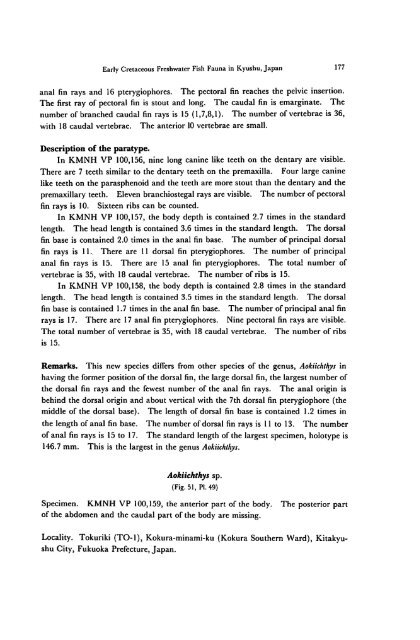Early Cretaceous Freshwater Fish Fauna in Kyushu, Japan
Early Cretaceous Freshwater Fish Fauna in Kyushu, Japan
Early Cretaceous Freshwater Fish Fauna in Kyushu, Japan
Create successful ePaper yourself
Turn your PDF publications into a flip-book with our unique Google optimized e-Paper software.
<strong>Early</strong> <strong>Cretaceous</strong> <strong>Freshwater</strong> <strong>Fish</strong> <strong>Fauna</strong> <strong>in</strong> <strong>Kyushu</strong>, <strong>Japan</strong> 177<br />
anal f<strong>in</strong> rays and 16 pterygiophores. The pectoral f<strong>in</strong> reaches the pelvic <strong>in</strong>sertion.<br />
The first ray of pectoral f<strong>in</strong> is stout and long. The caudal f<strong>in</strong> is emarg<strong>in</strong>ate. The<br />
number of branched caudal f<strong>in</strong> rays is 15 (1,7,8,1). The number of vertebrae is 36,<br />
with 18 caudal vertebrae.<br />
The anterior 10 vertebrae are small.<br />
Description of the paratype.<br />
In KMNH VP 100,156, n<strong>in</strong>e long can<strong>in</strong>e like teeth on the dentary are visible.<br />
There are 7 teeth similar to the dentary teeth on the premaxilla. Four large can<strong>in</strong>e<br />
like teeth on the parasphenoid and the teeth are more stout than the dentary and the<br />
premaxillary teeth. Eleven branchiostegal rays are visible. The number of pectoral<br />
f<strong>in</strong> rays is 10. Sixteen ribs can be counted.<br />
In KMNH VP 100,157, the body depth is conta<strong>in</strong>ed 2.7 times <strong>in</strong> the standard<br />
length. The head length is conta<strong>in</strong>ed 3.6 times <strong>in</strong> the standard length. The dorsal<br />
f<strong>in</strong> base is conta<strong>in</strong>ed 2.0 times <strong>in</strong> the anal f<strong>in</strong> base. The number of pr<strong>in</strong>cipal dorsal<br />
f<strong>in</strong> rays is 11. There are 11 dorsal f<strong>in</strong> pterygiophores. The number of pr<strong>in</strong>cipal<br />
anal f<strong>in</strong> rays is 15. There are 15 anal f<strong>in</strong> pterygiophores. The total number of<br />
vertebrae is 35, with 18 caudal vertebrae. The number of ribs is 15.<br />
In KMNH VP 100,158, the body depth is conta<strong>in</strong>ed 2.8 times <strong>in</strong> the standard<br />
length. The head length is conta<strong>in</strong>ed 3.5 times <strong>in</strong> the standard length. The dorsal<br />
f<strong>in</strong> base is conta<strong>in</strong>ed 1.7 times <strong>in</strong> the anal f<strong>in</strong> base. The number of pr<strong>in</strong>cipal anal f<strong>in</strong><br />
rays is 17. There are 17 anal f<strong>in</strong> pterygiophores. N<strong>in</strong>e pectoral f<strong>in</strong> rays are visible.<br />
The total number of vertebrae is 35, with 18 caudal vertebrae.<br />
is 15.<br />
The number of ribs<br />
Remarks. This new species differs from other species of the genus, Aokiichthys <strong>in</strong><br />
hav<strong>in</strong>g the former position ofthe dorsal f<strong>in</strong>, the large dorsal f<strong>in</strong>, the largest number of<br />
the dorsal f<strong>in</strong> rays and the fewest number of the anal f<strong>in</strong> rays. The anal orig<strong>in</strong> is<br />
beh<strong>in</strong>d the dorsal orig<strong>in</strong> and about vertical with the 7th dorsal f<strong>in</strong> pterygiophore (the<br />
middle of the dorsal base). The length of dorsal f<strong>in</strong> base is conta<strong>in</strong>ed 1.2 times <strong>in</strong><br />
the length of anal f<strong>in</strong> base. The number of dorsal f<strong>in</strong> rays is 11 to 13. The number<br />
of anal f<strong>in</strong> rays is 15 to 17. The standard length of the largest specimen, holotype is<br />
146.7 mm. This is the largest <strong>in</strong> the genus Aokiichthys.<br />
Aokiichthys sp.<br />
(Fig. 51, PI. 49)<br />
Specimen. KMNH VP 100,159, the anterior part of the body. The posterior part<br />
of the abdomen and the caudal part of the body are miss<strong>in</strong>g.<br />
Locality. Tokuriki (TO-1), Kokura-m<strong>in</strong>ami-ku (Kokura Southern Ward), Kitakyu<br />
shu City, Fukuoka Prefecture, <strong>Japan</strong>.

















